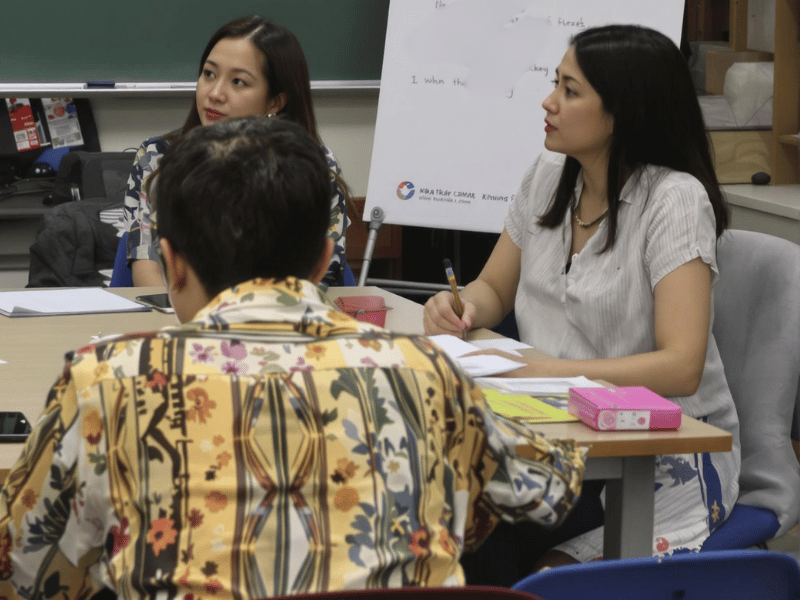Teacher Burnout in Vietnam Isn't Going Away
Teacher Burnout in Vietnamese Bilingual Schools
Teacher burnout hit close to home in Vietnam.
As Managing Director of a K-12 bilingual school in Ho Chi Minh City during the pandemic, I saw the weight teachers carried. Both local and international staff faced challenges that changed them.
Remote teaching strained everyone. The isolation took its toll. And when we returned to classrooms, many teachers brought invisible scars back with them.
Our school was new, still finding its footing when COVID hit. This complicated everything. Teachers adapted, pivoted, and persevered. But there was a cost.
I'm sharing what I observed because teacher burnout isn't just about personal coping strategies. It's about systems, expectations, and support.
This post explores what burnout looked like in our context, what helped, what didn't, and what meaningful change might require.
It's not just teachers who need to adapt - it's everyone involved in education.
Defining Teacher Burnout
What is "teacher burnout?"
It's a slow drain of passion and energy that leaves educators exhausted, detached, and questioning their impact. This occupational hazard develops when teaching demands consistently outpace personal resources.
Christina Maslach, the pioneer researcher in burnout, found that when external pressures exceed coping abilities, the professional flame dims.
For teachers in Vietnam, I saw these pressures intensified dramatically during COVID.
Research from Education Support's Teacher Wellbeing Index shows persistently high levels of stress, anxiety, and burnout among teachers.
In fact, 77% of education staff experience symptoms of poor mental health due to work.
And the pandemic turned this chronic problem into a crisis.
A RAND Corporation study found nearly 7 in 10 teachers reporting significant mental health concerns - a statistic I saw play out in real time across our Ho Chi Minh City classrooms.
Vietnamese teachers faced unique challenges. The Southeast Asian Teachers Competency Framework emphasizes cultural expectations that often prevent educators from acknowledging struggles.
When burnout happens, it can feel like something much more than fatigue.
It is not uncommon for even empathetic and warm teachers to develop cynicism toward students, parents and colleagues.
The sense of accomplishment can whither even while they're working harder than ever.
Addressing burnout in Vietnam's education system requires more than individual coping strategies. It demands structural reform, cultural shifts, and evidence-based interventions that recognize teaching as both an intellectual and emotional profession.
Pandemic-Related Stressors
The COVID-19 pandemic has introduced a new set of challenges and stressors for educators, compounding the pre-existing issues that contribute to teacher burnout.
Surveys conducted during the pandemic reveal alarming teacher burnout statistics, with nearly 70% of respondents expressing concerns about their mental health and well-being.
The sudden shift to remote learning, coupled with the fear of contracting the virus, has greatly increased job-related stress among teachers.
For international teachers, the pandemic was particularly isolating. Many expatriate educators working overseas lacked the strong personal support networks they would typically rely on.
Being far from family and navigating lockdowns in an unfamiliar country exacerbated feelings of loneliness. I saw several teachers struggle emotionally, not only with their professional responsibilities but also with a profound sense of disconnection from their support systems.
Studies have shown that the levels of stress and anxiety experienced by educators are strongly correlated with factors such as workload, student behavior, and lack of administrative support.
Overwhelming Workload
One of the most significant factors contributing to teacher burnout is the overwhelming workload that educators face on a daily basis.
Teachers are expected to handle a multitude of tasks, including lesson planning, grading, administrative duties, and managing student behavior, all while working toward providing high-quality instruction.
This excessive workload can lead to increased stress levels and emotional exhaustion, which are key dimensions of burnout.
Studies have shown a strong correlation between burnout and workload, with teachers experiencing higher levels of burnout when their workload is perceived as unmanageable.
The constant pressure to meet deadlines, adapt to changing curriculum requirements, and address the diverse needs of students can leave teachers feeling overwhelmed and drained.
This type of burnout, characterized by emotional exhaustion and reduced personal accomplishment, can have detrimental effects on both the well-being of teachers and the quality of education they provide.
Lack of Support
In addition to the overwhelming workload, another significant contributor to teacher burnout is the lack of support from administrators, colleagues, and the education system as a whole.
Public school teachers often feel isolated and unsupported when dealing with challenging student behaviors and the daily stresses of their job. This lack of support can lead to feelings of frustration, helplessness, and ultimately, burnout.
School administrators play an indispensable role in preventing teacher burnout by fostering a supportive and collaborative work environment.
They should actively listen to teachers' concerns, provide resources and training to help manage stress, and offer guidance in dealing with difficult situations. Additionally, administrators should prioritize the mental health of their staff and create a culture that encourages self-care and work-life balance.
Emotional Toll
Teaching is a deeply emotional profession that requires educators to invest their hearts and minds into their students' well-being and academic success.
The emotional toll of teaching can be profound, with studies revealing high levels of stress, anxiety, and depression among educators. Excessive demands on teachers' energy and resources can lead to severe burnout, negatively impacting their mental health and overall well-being.
I remember speaking to a teacher in my school who broke down one day, not because of a single event, but because of accumulated emotional fatigue.
They felt torn between their desire to support their students and their inability to recharge emotionally after months of working in isolation during the pandemic.
These moments are heartbreaking because they show how much teachers care but also how fragile the balance between giving and recovering can become.
To counteract some of this emotional toll, I organized virtual social gatherings during the pandemic.
We experimented with digital platforms where teachers could meet their colleagues, have a drink – albeit remotely – and get to know each other.
These moments of connection gave many staff members a sense of community when they were feeling particularly isolated.
Also, I organized online quizzes with prizes and even art workshops to bring some lighthearted fun into their weeks. Small initiatives like these made a big difference in helping staff feel seen and valued.
But sometimes, not enough.
Job dissatisfaction, often stemming from challenging student behavior and a feeling of lack of administrative support, further exacerbates the effects of stress on teachers.
The COVID-19 pandemic has only heightened these concerns, with nearly 70% of teachers reporting worries about their mental health during this time.
As the emotional toll on educators continues to rise, it is pivotal to prioritize their well-being by providing adequate support, resources, and interventions to address this critical issue.
Student Behavior Challenges
Student misbehavior is a significant source of stress and anxiety for many teachers, often leading to feelings of frustration, helplessness, and burnout. Disruptive classroom behavior can hinder student motivation and learning, while also contributing to high levels of anxiety among educators.
Studies have shown that stress from student behaviour is a major factor in the prevalence of anxiety within the education field.
During my time in Vietnam, I saw how student behavior often became a flashpoint for burnout, especially after the pandemic.
Many students returned to school with heightened social and emotional needs that teachers weren’t fully equipped to address.
For some teachers, managing behavioral challenges felt like yet another mountain to climb, one they didn’t feel prepared for after such an intense period of stress and uncertainty.
Teachers facing constant behavioral challenges may struggle to maintain a positive learning environment, leading to decreased job satisfaction and increased burnout risk.
To address this issue, it is indispensable for school administrators to provide teachers with the necessary support, resources, and training to effectively manage student behavior.
This may include implementing evidence-based classroom management strategies, fostering positive student-teacher relationships, and promoting a school-wide culture of respect and responsibility.
Work-Life Imbalance
Maintaining a healthy work-life balance is a persistent challenge for many teachers, as the demands of their profession often spill over into their personal lives.
The struggle to juggle lesson planning, grading, and extracurricular responsibilities with family commitments and personal time can take a toll on both physical health and mental well-being.
One thing I observed in my role was how difficult it was for international teachers to maintain any semblance of balance.
Many were living away from their families, which meant that even their personal lives were intertwined with their professional environment.
For example, a teacher once shared that they felt like their apartment was just an extension of the school because it was the only place they had to retreat to, yet they were still grading papers there late into the night.
Experienced educators are not immune to this burnout factor, as even those with years of teaching experience may find it difficult to disconnect from work and fully engage in their personal lives.
When staff were finally able to return to work, I took steps to create a more supportive and relaxing environment. One initiative was bringing in a massage therapist to the teacher lounge to give neck and shoulder massages during breaks.
Teachers appreciated the opportunity to unwind, even if just for a few minutes, and it demonstrated to them that their well-being was a priority.
To combat this issue, schools should consider implementing policies that promote better work-life balance, such as designated mental health days, reasonable workload expectations, and support for teachers' personal and professional development.
A Feeling of Inadequate Compensation
In addition to the challenges of maintaining a healthy work-life balance, it is not uncommon for educators to complain of inadequate compensation as another significant factor contributing to teacher burnout.
Many teachers in public and private schools alike struggle with a sense that they have low salaries in comparison to their workload and that pay fails to reflect the demanding nature of their work.
The long hours spent preparing lessons, grading assignments, and managing classrooms often extend well beyond the official school day.
This perceived discrepancy between workload and compensation can lead to increased anxiety and perceived stress among educators.
And, insufficient pay can make it difficult for teachers to afford essential resources for their own well-being, such as mental health support or stress-reducing activities.
To address this issue, it is imperative for school administrators and policymakers to prioritize fair compensation that acknowledges the critical role teachers play in shaping young minds.
By investing in competitive salaries and benefits, we can help alleviate the financial pressures that contribute to burnout and promote better overall health in teachers.
Ultimately, valuing our educators through adequate compensation is not only a matter of justice but also a pivotal step in ensuring the long-term success and well-being of our educational system.
Strategies for Prevention
Given the alarming prevalence of burnout among educators, it is essential to explore effective strategies for preventing this debilitating condition. A wide range of interventions can be implemented to support teachers' well-being.
Mindfulness practice has shown promise in reducing stress and promoting resilience. Incorporating mindfulness techniques into professional development programs can equip teachers with valuable coping skills.
In addition to mindfulness workshops, I found that organizing interactive activities helped to relieve stress and foster community.
During the pandemic, our school hosted art workshops that encouraged teachers to tap into their creativity. These were a hit and gave many staff members an outlet to decompress.
Whether it was painting or simply chatting with colleagues in a non-work-related setting, it helped reduce stress.
Additionally, fostering a supportive school culture that prioritizes open communication and collaboration can mitigate feelings of isolation and overwhelm.
Relevant studies, including cross-sectional research, have highlighted the importance of proactive measures such as workload management and access to mental health resources.
However, it is indispensable to address methodological issues in future research to develop evidence-based prevention strategies.
When paired with virtual events like quizzes and digital meetups, these activities strengthened the sense of connection among staff, even when physical distance was unavoidable.
Teachers began to feel like they were part of a team again, which significantly boosted morale.
Systemic Changes Needed
While individual interventions can alleviate the symptoms of burnout, addressing the root causes requires systemic changes within the education system.
Primary and secondary school teachers face increasing demands, leading to high levels of anxiety and depression.
During my time as a school managing director, I realized that systemic issues often compounded the personal challenges teachers faced.
For instance, international teachers were not just navigating the complexities of their roles but also dealing with cultural adjustments, language barriers, and, during the pandemic, heightened restrictions that isolated them further. Without intentional systemic support, their stress only grew.
To mitigate these issues, educational institutions must prioritize teacher well-being by implementing policies that reduce workload, improve student behavior management, and provide fair employment conditions.
Fundamentally, schools need to offer substantial support to teachers, as a lack of such support is a significant factor contributing to anxiety.
One of the systemic changes I tried to implement was creating a school culture that emphasized both personal and professional growth.
By offering teachers access to training opportunities and pairing this with initiatives like regular well-being check-ins, we aimed to build a sustainable environment that reduced feelings of burnout.
I also encouraged open feedback, so staff felt empowered to voice their concerns and suggest improvements.
By fostering a supportive work environment and addressing the systemic factors that contribute to burnout, schools can create a healthier and more sustainable teaching profession.
This, in turn, will benefit both teachers and students, as educators who feel valued and supported are better equipped to provide high-quality education.
Ultimately, investing in teacher well-being through systemic changes is essential for the long-term success of our education system, ensuring that dedicated professionals can continue to inspire and guide future generations without sacrificing their own mental health and well-being.
Final Say on Teacher Burnout
Reflecting on my experiences, I can see that preventing teacher burnout requires more than just isolated fixes; it calls for a cultural shift within schools.
Small actions, like the art workshops, massages, and virtual gatherings I introduced, helped alleviate some immediate stress, but they were only part of the solution.
The bigger picture involves rethinking how we approach teacher support, from workload policies to emotional well-being initiatives.
In a world where educators are expected to be superhuman, teacher burnout persists as an ironic reminder of the system's failings. As society demands more from those who shape future generations, it simultaneously neglects their well-being.
The solution lies not in empty platitudes, but in systemic changes that prioritize the mental health and support of educators. Only by valuing the well-being of teachers can the education system hope to thrive and inspire future minds.









